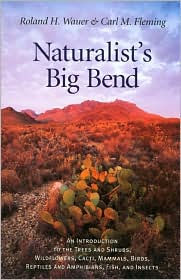Naturalist's Big Bend: An Introduction to the Trees and Shrubs, Wildflowers, Cacti, Mammals, Birds, Reptiles and Amphibians, Fish, and Insects
In southwest Texas where the Rio Grande arcs southward into Mexico lies Big Bend National Park, 708,221 acres of river floodplain, desert, grasslands, and majestic mountains, a richly varied environment that exist more or less as it did before man’s arival. The wealth of the Big Bend is in its dramatic landscape, which provides natural habitats ranging form desert to alpine, and its consequently impressive variety of flora and fauna.
Intended as a biological introduction to one of the nation’s outstanding natural systems, Naturalist’s Big Bend highlights the distinctive plants and animal of the region, such as the century plant, which grows twenty-five to fifty-five years, blooms magnificently, and dies; candelilla, from which wax is made; prickly pear cactus; the javelina, North America’s only native pig; the colima warbler; the rare Texas lyre snake; the Big Bend gambusia fish; the tarantula; and the Big Bend quonker katydid.
This comprehensive field guide, revised and enlarged in a new edition, describes the area’s archaeology and history, and details the characteristics and habitats of Big Bend’s trees and shrubs, wildflowers, cacti, mammals, birds, reptiles and amphibians, fish, and invertebrates. It also outlines walking and driving tours of the most likely spots for sighting these plants and animals. An extensive bibliography is included.
"1100004846"
Intended as a biological introduction to one of the nation’s outstanding natural systems, Naturalist’s Big Bend highlights the distinctive plants and animal of the region, such as the century plant, which grows twenty-five to fifty-five years, blooms magnificently, and dies; candelilla, from which wax is made; prickly pear cactus; the javelina, North America’s only native pig; the colima warbler; the rare Texas lyre snake; the Big Bend gambusia fish; the tarantula; and the Big Bend quonker katydid.
This comprehensive field guide, revised and enlarged in a new edition, describes the area’s archaeology and history, and details the characteristics and habitats of Big Bend’s trees and shrubs, wildflowers, cacti, mammals, birds, reptiles and amphibians, fish, and invertebrates. It also outlines walking and driving tours of the most likely spots for sighting these plants and animals. An extensive bibliography is included.
Naturalist's Big Bend: An Introduction to the Trees and Shrubs, Wildflowers, Cacti, Mammals, Birds, Reptiles and Amphibians, Fish, and Insects
In southwest Texas where the Rio Grande arcs southward into Mexico lies Big Bend National Park, 708,221 acres of river floodplain, desert, grasslands, and majestic mountains, a richly varied environment that exist more or less as it did before man’s arival. The wealth of the Big Bend is in its dramatic landscape, which provides natural habitats ranging form desert to alpine, and its consequently impressive variety of flora and fauna.
Intended as a biological introduction to one of the nation’s outstanding natural systems, Naturalist’s Big Bend highlights the distinctive plants and animal of the region, such as the century plant, which grows twenty-five to fifty-five years, blooms magnificently, and dies; candelilla, from which wax is made; prickly pear cactus; the javelina, North America’s only native pig; the colima warbler; the rare Texas lyre snake; the Big Bend gambusia fish; the tarantula; and the Big Bend quonker katydid.
This comprehensive field guide, revised and enlarged in a new edition, describes the area’s archaeology and history, and details the characteristics and habitats of Big Bend’s trees and shrubs, wildflowers, cacti, mammals, birds, reptiles and amphibians, fish, and invertebrates. It also outlines walking and driving tours of the most likely spots for sighting these plants and animals. An extensive bibliography is included.
Intended as a biological introduction to one of the nation’s outstanding natural systems, Naturalist’s Big Bend highlights the distinctive plants and animal of the region, such as the century plant, which grows twenty-five to fifty-five years, blooms magnificently, and dies; candelilla, from which wax is made; prickly pear cactus; the javelina, North America’s only native pig; the colima warbler; the rare Texas lyre snake; the Big Bend gambusia fish; the tarantula; and the Big Bend quonker katydid.
This comprehensive field guide, revised and enlarged in a new edition, describes the area’s archaeology and history, and details the characteristics and habitats of Big Bend’s trees and shrubs, wildflowers, cacti, mammals, birds, reptiles and amphibians, fish, and invertebrates. It also outlines walking and driving tours of the most likely spots for sighting these plants and animals. An extensive bibliography is included.
17.95
In Stock
5
1

Naturalist's Big Bend: An Introduction to the Trees and Shrubs, Wildflowers, Cacti, Mammals, Birds, Reptiles and Amphibians, Fish, and Insects
208
Naturalist's Big Bend: An Introduction to the Trees and Shrubs, Wildflowers, Cacti, Mammals, Birds, Reptiles and Amphibians, Fish, and Insects
208Paperback(Revised Edition)
$17.95
17.95
In Stock

Product Details
| ISBN-13: | 9781585441563 |
|---|---|
| Publisher: | Texas A&M University Press |
| Publication date: | 11/21/2001 |
| Series: | Louise Lindsey Merrick Natural Environment Series , #33 |
| Edition description: | Revised Edition |
| Pages: | 208 |
| Product dimensions: | 6.12(w) x 9.25(h) x (d) |
About the Author
From the B&N Reads Blog
